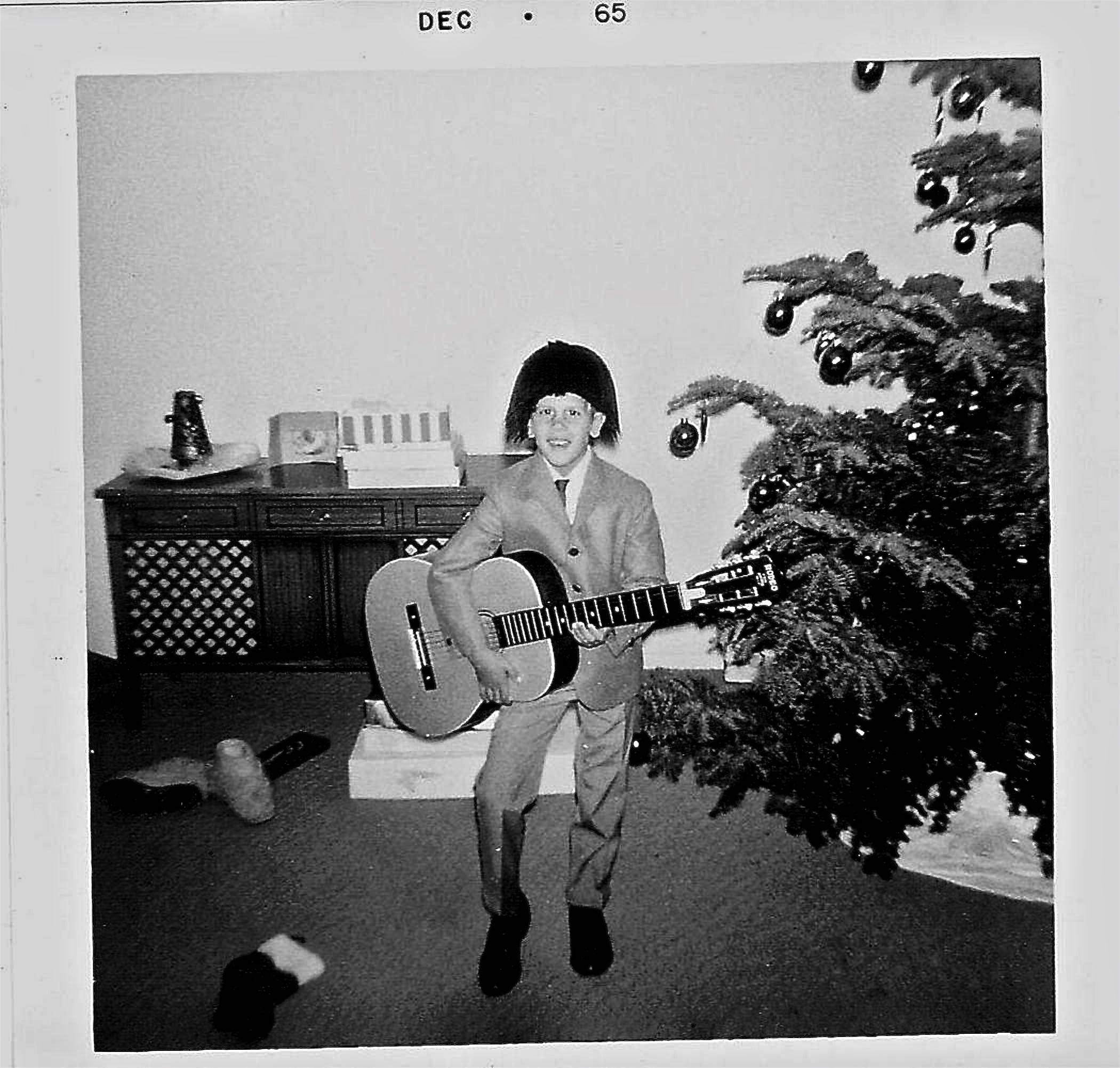Eric Henderson with Antonia Morales and Andres Segovia
Antonia Morales and My Introduction to Spanish Guitar
At nine-years-old, the second half of fourth grade, I was to meet Antonia Morales who my parents had found to teach me Spanish guitar. Antonia was to shape my life profoundly in ways that are too numerous to list. She was a flamenco dancer, personal assistant and dance coach to such stars as Rita Hayworth and Tyrone Powers who remained close friends of Antonia’s for the rest of their lives. Antonia toured for Columbia Artists’ Management as a Flamenco dancer as well as a flamenco guitarist. She had studied guitar in Spain and was close friends and probably an intimate of Andres Segovia, to whom she was later to introduce me and to arrange for me to study with.
Antonia was my mentor, my teacher, facilitator, and guardian. She taught me the foundations of technique and musicianship. Her knowledge and familiarity with Spanish culture and her intellect were profound. To this day I still find myself remembering and consequently applying insights and advice she gave me with such generosity and integrity that upon recalling these I have a sense of overwhelming gratefulness.
My father introduced me to Antonia; here is the story of how we met, in his words:
When Eric was nine-years-old, we moved to Laguna Beach. Eric had been showing some promise musically, having taken some lessons while in Claremont. His mother and I hoped we could find a guitar teacher in Laguna who would be interested in giving Eric lessons. In the meantime, my youngest son, Chris, joined the Cub Scouts and at one of his meetings, I noticed a guitar leaning in the corner. The hostess of the meeting was taking lessons from a teacher in Laguna named Antonia Morales, and she gave me Antonia’s phone number. I called her and asked if she would be interested in hearing my son play and in giving us some advice. Reluctantly, she agreed to see him that afternoon, informing me that she didn’t usually take students so young.
After knocking several times, Antonia opened her door. Eric, his guitar in hand, was hustled into the apartment, and as the door closed I hear Antonia say, “Come back in an hour.” I was back in an hour, hoping my son was still in one piece, knocking on the door again. I heard a loud voice say, “Come back in another hour.” This time I sat on the steps for the hour, still concerned over what this lady was doing to my son.
Finally, the door opened and out came Eric, followed by Antonia. Before I could speak, Antonia said, “Have him back here tomorrow at three o’clock, and he can’t learn anything on this awful thing,” pointing to his guitar. Ultimately she was to procure an excellent Spanish guitar for Eric, and so began the many years of a remarkable experience for my son and for the whole family.
At nine-years-old, I had become frustrated with the situation I found myself in, musically. The absence of other people to jam with and being so young that older skilled players would not consider me as a band member forced me to explore other types of music. When my mother played some records of Andres Segovia and Flamenco guitarist, Sabicas, I head the other possibilities and capabilities of what a single guitar could do. This period also coincided with the release and success of Mason Williams’ “Classical Gas”, and shortly after that the Doors’ song “Spanish Caravan;” both hits featuring Spanish guitar. The instrumental hit, “Classical Gas,” made the guitar sound important and grant with its orchestration and crafted arrangements; a kind of pop guitar concerto. “Spanish Caravan” brought my attention to the Spanish roots of the guitar with its thematic quote that I was later learn came from Isaac Albeniz’s “Asturias.” I doubt that my interest in classical guitar could have been so intensely inspired without those songs bridging the genres. Another thing that was taking placed at this time was the guitar solo, and the rise of rock guitar Gods like dick Dale, Eric Clapton and my own hero, Jimi Hendrix. Antonia Morales came into my life and gave me a focus I was in need of to pull all of these impressions together.
Antonia could walk through any door, and engage with credibility, anyone she had a mind to. Her vast number of friends and connections to the prominent artists of the day was astounding. She had exquisite taste and an enormous sense of propriety and discernment. She educated me in the arts, Spanish language, and literature, as well as in manners and etiquette.
Under her tutelage, by the time I was 12-years-old, I was able to play some Bach preludes, as well as “Twenty Studies” by Fernando Sor, several Giuliani pieces, music by Villa Lobos, Francisco Tarrega, Aguado and some preludes by Ponce. She was strict and demanding but always with loving patience. I currently have a student who is 10-years-old and talented. He reminds me of myself at that age, as he is as stubborn as I was about conquering whatever difficulty presents itself in the music, approaching his task with a keen sense of melody and rhythm. The privilege of teaching a gifted student who trusts and follows suggestion is an enormous responsibility. As I look back to my time with Antonia I feel regret that at that age I didn’t have more capacity to cherish and appreciate the care and concern she had for me, for the same reasons. Age and experience have taught me to be more aware of the generosity and faithfulness of those who shaped and edified my life.
Andres Segovia in 1962
When I was twelve years old, Andres Segovia was going to give a recital in LA. This would be the third concert I saw him perform, and Antonia told me to write a short letter to him so that it would be sent backstage. In the letter I told the maestro my age and that I had played guitar for over 6 years and was a student of Antonia’s. Her teacher in Spain happened to be Aureo Herrero, who had studied for years, privately with Segovia as he had been taken under Segovia’s wing at a young age and went on to study Arco Bass and music theory at the conservatory in Madrid. (Classical guitar was at that time not considered a legitimate instrument and therefore not offered at the conservatory.) The fact that Segovia was so familiar with Aureo Herrero, but also had a decades-long friendship with Antonia herself, may have been the reason he was inclined to let me come backstage and meet him after the concert.
When the concert ended, Antonia and I went to the backstage entrance and were received graciously. I remember Segovia embracing Antonia and I was scooped up along with her to a more private room where the two of them talked briefly in Spanish. Then turning towards me, he asked me to play for him. I played Sor Estudio #12 and as soon as I finished he said to Antonia that if she could get me to Spain to Madrid, he would spend time with me and maybe teach me when he was not on tour.
Upon informing my mother and father of this extraordinary turn of events, my dad was overwhelmed with excitement and said: “We’ve got to go to Spain as soon as possible!”
The small town of Laguna Beach was a really supportive community for the arts. The Soroptimist Club, the Rotary Club and various successful business people of the town banded together with a humbling show of support and pride when they became aware of the possibility of my studying with Segovia in Madrid. There was no way my parents could afford to send me along with Antonia, who was willing to act as my legal guardian while I was in Spain. The plan that my parents and the town of Laguna Beach came up with was this: Once a year I would perform a recital for the purpose of raising funds and awareness of the financial assistance necessary to pay for my travel expenses (as well as Antonia’s for acting as my guardian), living expenses and costs of education and lessons for 9 to 10 months every year. The concert I provided was a way to show my progress and level of my performance abilities to the supporters and audience. It was a good way to be accountable. In addition, I was also asked to write regularly about my experiences and time spent with all of the people I studied under. The community of Laguna Beach was truly a wonderful extended family, in a sense.
Plaza Mayor in Mardrid, Spain
My first trip to Madrid was in June of 1971. I was thirteen-years-old. My father went with me and stayed for the first three months. We flew on a World Airways plane that was the cheapest airfare possible. It went to Spain via London and we arrived in Madrid in the morning. Antonia had already left in May and was waiting for us to arrive. I remember the taxi ride from the airport, our arrival in the oldest section of the city where I was to live for the better part of the next four years. It was frightening to be entering into a massive, ancient cosmopolitan city with a past that spread over centuries. There were large, imposing brown buildings and bustling streets, a real culture shock coming from a small southern California beach town. I remember my dad turning to me in the taxi and saying, “Well, this is where you’re going to be for the next few months.” Those months became years.
Stay tuned for more of my memoirs of the guitar. You can read Part I and Part II on my blog. Visit the store to listen and download my various works and ensembles.
Latin-grammy award-winning artist, William Sigismondi and I will be in concert for the first time together. I cannot begin to explain to you the synergies we have and the beautiful repertoire that comes out of our sessions.
It will be great to see you all at the concert on the 24th of March at Bridge Hall in Laguna Beach. You can buy tickets here.
Also, make sure to sign up to get the latest news and updates.



















